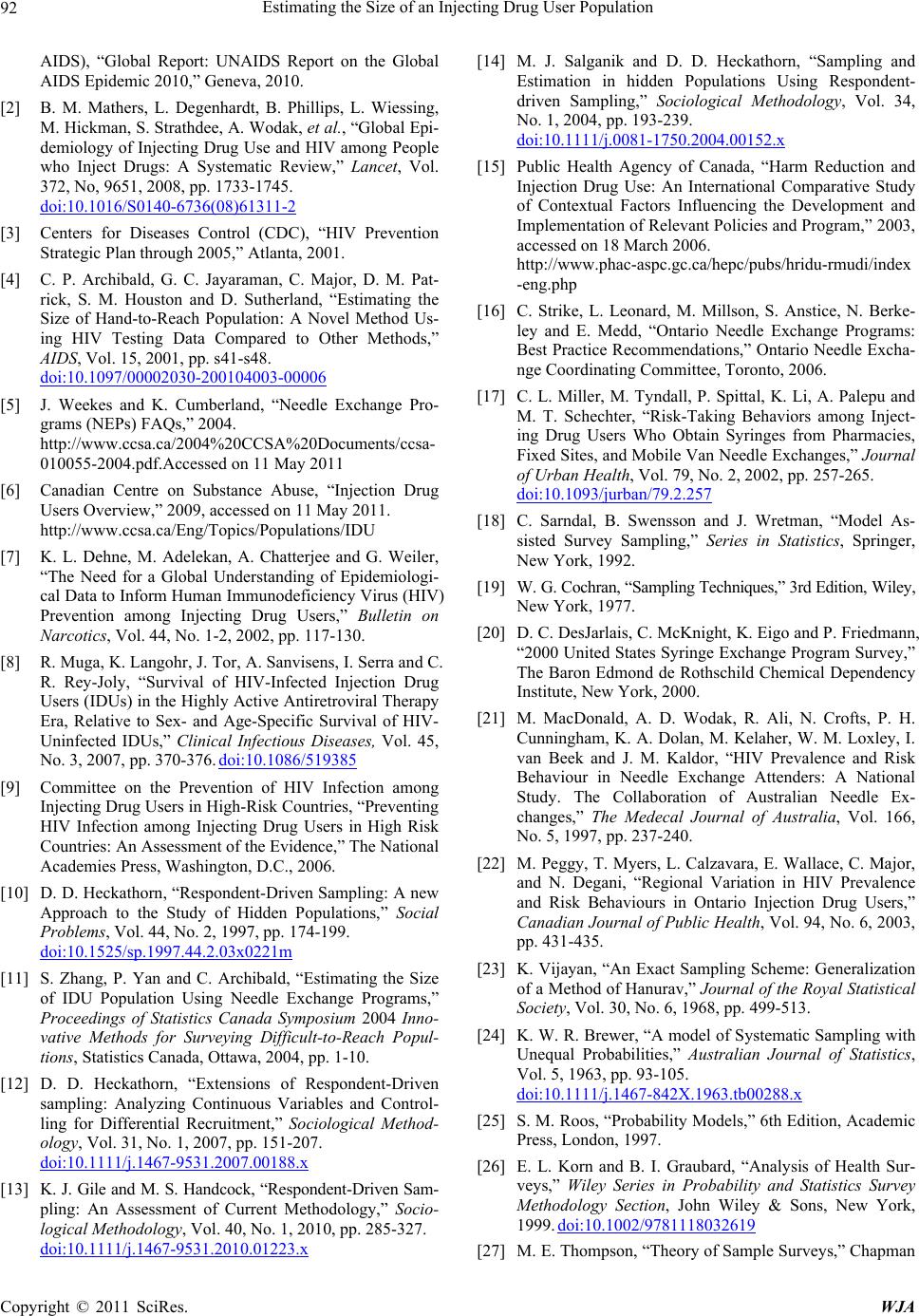
Estimating the Size of an Injecting Drug User Population
92
AIDS), “Global Report: UNAIDS Report on the Global
AIDS Epidemic 2010,” Geneva, 2010.
[2] B. M. Mathers, L. Degenhardt, B. Phillips, L. Wiessing,
M. Hickman, S. Strathdee, A. Wodak, et al., “Global Epi-
demiology of Injecting Drug Use and HIV among People
who Inject Drugs: A Systematic Review,” Lancet, Vol.
372, No, 9651, 2008, pp. 1733-1745.
doi:10.1016/S0140-6736(08)61311-2
[3] Centers for Diseases Control (CDC), “HIV Prevention
Strategic Plan through 2005,” Atlanta, 2001.
[4] C. P. Archibald, G. C. Jayaraman, C. Major, D. M. Pat-
rick, S. M. Houston and D. Sutherland, “Estimating the
Size of Hand-to-Reach Population: A Novel Method Us-
ing HIV Testing Data Compared to Other Methods,”
AIDS, Vol. 15, 2001, pp. s41-s48.
doi:10.1097/00002030-200104003-00006
[5] J. Weekes and K. Cumberland, “Needle Exchange Pro-
grams (NEPs) FAQs,” 2004.
http://www.ccsa.ca/2004%20CCSA%20Documents/ccsa-
010055-2004.pdf.Accessed on 11 May 2011
[6] Canadian Centre on Substance Abuse, “Injection Drug
Users Overview,” 2009, accessed on 11 May 2011.
http://www.ccsa.ca/Eng/Topics/Populations/IDU
[7] K. L. Dehne, M. Adelekan, A. Chatterjee and G. Weiler,
“The Need for a Global Understanding of Epidemiologi-
cal Data to Inform Human Immunodeficiency Virus (HIV)
Prevention among Injecting Drug Users,” Bulletin on
Narcotics, Vol. 44, No. 1-2, 2002, pp. 117-130.
[8] R. Muga, K. Langohr, J. Tor, A. Sanvisens, I. Serra and C.
R. Rey-Joly, “Survival of HIV-Infected Injection Drug
Users (IDUs) in the Highly Active Antiretroviral Therapy
Era, Relative to Sex- and Age-Specific Survival of HIV-
Uninfected IDUs,” Clinical Infectious Diseases, Vol. 45,
No. 3, 2007, pp. 370-376. doi:10.1086/519385
[9] Committee on the Prevention of HIV Infection among
Injecting Drug Users in High-Risk Countries, “Preventing
HIV Infection among Injecting Drug Users in High Risk
Countries: An Assessment of the Evidence,” The National
Academies Press, Washington, D.C., 2006.
[10] D. D. Heckathorn, “Respondent-Driven Sampling: A new
Approach to the Study of Hidden Populations,” Social
Problems, Vol. 44, No. 2, 1997, pp. 174-199.
doi:10.1525/sp.1997.44.2.03x0221m
[11] S. Zhang, P. Yan and C. Archibald, “Estimating the Size
of IDU Population Using Needle Exchange Programs,”
Proceedings of Statistics Canada Symposium 2004 Inno-
vative Methods for Surveying Difficult-to-Reach Popul-
tions, Statistics Canada, Ottawa, 2004, pp. 1-10.
[12] D. D. Heckathorn, “Extensions of Respondent-Driven
sampling: Analyzing Continuous Variables and Control-
ling for Differential Recruitment,” Sociological Method-
ology, Vol. 31, No. 1, 2007, pp. 151-207.
doi:10.1111/j.1467-9531.2007.00188.x
[13] K. J. Gile and M. S. Handcock, “Respondent-Driven Sam-
pling: An Assessment of Current Methodology,” Socio-
logical Methodology, Vol. 40, No. 1, 2010, pp. 285-327.
doi:10.1111/j.1467-9531.2010.01223.x
[14] M. J. Salganik and D. D. Heckathorn, “Sampling and
Estimation in hidden Populations Using Respondent-
driven Sampling,” Sociological Methodology, Vol. 34,
No. 1, 2004, pp. 193-239.
doi:10.1111/j.0081-1750.2004.00152.x
[15] Public Health Agency of Canada, “Harm Reduction and
Injection Drug Use: An International Comparative Study
of Contextual Factors Influencing the Development and
Implementation of Relevant Policies and Program,” 2003,
accessed on 18 March 2006.
http://www.phac-aspc.gc.ca/hepc/pubs/hridu-rmudi/index
-eng.php
[16] C. Strike, L. Leonard, M. Millson, S. Anstice, N. Berke-
ley and E. Medd, “Ontario Needle Exchange Programs:
Best Practice Recommendations,” Ontario Needle Excha-
nge Coordinating Committee, Toronto, 2006.
[17] C. L. Miller, M. Tyndall, P. Spittal, K. Li, A. Palepu and
M. T. Schechter, “Risk-Taking Behaviors among Inject-
ing Drug Users Who Obtain Syringes from Pharmacies,
Fixed Sites, and Mobile Van Needle Exchanges,” Journal
of Urban Health, Vol. 79, No. 2, 2002, pp. 257-265.
doi:10.1093/jurban/79.2.257
[18] C. Sarndal, B. Swensson and J. Wretman, “Model As-
sisted Survey Sampling,” Series in Statistics, Springer,
New York, 1992.
[19] W. G. Cochran, “Sampling Techniques,” 3rd Edition, Wiley,
New York, 1977.
[20] D. C. DesJarlais, C. McKnight, K. Eigo and P. Friedmann,
“2000 United States Syringe Exchange Program Survey,”
The Baron Edmond de Rothschild Chemical Dependency
Institute, New York, 2000.
[21] M. MacDonald, A. D. Wodak, R. Ali, N. Crofts, P. H.
Cunningham, K. A. Dolan, M. Kelaher, W. M. Loxley, I.
van Beek and J. M. Kaldor, “HIV Prevalence and Risk
Behaviour in Needle Exchange Attenders: A National
Study. The Collaboration of Australian Needle Ex-
changes,” The Medecal Journal of Australia, Vol. 166,
No. 5, 1997, pp. 237-240.
[22] M. Peggy, T. Myers, L. Calzavara, E. Wallace, C. Major,
and N. Degani, “Regional Variation in HIV Prevalence
and Risk Behaviours in Ontario Injection Drug Users,”
Canadian Journal of Public Health, Vol. 94, No. 6, 2003,
pp. 431-435.
[23] K. Vijayan, “An Exact Sampling Scheme: Generalization
of a Method of Hanurav,” Journal of the Royal Statistical
Society, Vol. 30, No. 6, 1968, pp. 499-513.
[24] K. W. R. Brewer, “A model of Systematic Sampling with
Unequal Probabilities,” Australian Journal of Statistics,
Vol. 5, 1963, pp. 93-105.
doi:10.1111/j.1467-842X.1963.tb00288.x
[25] S. M. Roos, “Probability Models,” 6th Edition, Academic
Press, London, 1997.
[26] E. L. Korn and B. I. Graubard, “Analysis of Health Sur-
veys,” Wiley Series in Probability and Statistics Survey
Methodology Section, John Wiley & Sons, New York,
1999. doi:10.1002/9781118032619
[27] M. E. Thompson, “Theory of Sample Surveys,” Chapman
Copyright © 2011 SciRes. WJA